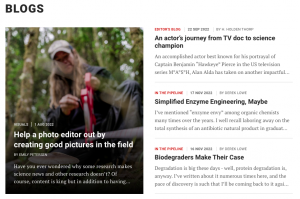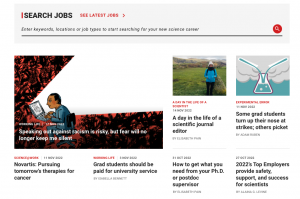When the American Association for the Advancement of Science (AAAS) made the decision to migrate Science.org to Literatum, they had a key goal in mind: to showcase their news and other non-scholarly content together with their research—on a single platform—and make it as visible as possible.
Founded in 1880, Science is at the center of scientific discovery. Its core mission is to communicate the value of science, and its digital content extends far beyond its highly cited primary research to include news articles, careers content, podcasts, videos, and Custom Publishing solutions.
 “Just because you write something doesn’t mean people will read it and understand it,” explains Chris Reid, Director of Product and Publishing Development at AAAS. “So we help them discover it, help them understand it, and then build on it from there.”
“Just because you write something doesn’t mean people will read it and understand it,” explains Chris Reid, Director of Product and Publishing Development at AAAS. “So we help them discover it, help them understand it, and then build on it from there.”
AAAS set out to find a new platform that could support their rich content. They needed a solution that could manage multiple workflows and highly visual news content beyond the boundaries of academic articles. “Our setup was difficult,” says Chris. “Our research content was all on one platform, our news content was all on a self-built Drupal platform, and then we also had blog content on WordPress.”
Ultimately, they needed to streamline burdensome processes and remove duplication. “On the outside, our website looked fine, but it didn’t really look fine on the inside,” Chris notes; “if you wanted to make relatively simple changes, you’d have to do it in two separate places. You’d need a development team to do it.”
A flexible solution, ready to implement
“What gave Atypon the real driving seat was their ability to show something that worked. They had this functionality already, and could adapt it.”
—Chris Reid
Instead of approaching platform providers with an RFP, as they had done in the past, AAAS asked bidders to deliver a proof of concept for their problem. Atypon’s solution? To apply highly flexible Digital Objects.

“A big benefit of the migration was getting everything consolidated on one platform, making it possible to retire multiple systems that AAAS were hosting internally, streamlining the production process,” says Ed Evans, an Atypon Solution Architect who worked with AAAS on the content migration.
Bringing all the content metadata together made it possible to relate different types of objects to each other, which would have been difficult—if not impossible—before. Science.org can now link news articles directly with a journal article; Digital Objects such as image files, videos, and podcasts can be embedded in a news article; and related journal articles can appear in the sidebar of a news article. “Cross-promotion of the different content types is probably the biggest win that putting everything in one platform makes possible,” says Ed.
Easier content discovery for readers
Consolidating AAAS content has other reader benefits, Ed explains: “Everything can live under one domain, which is good for accessibility, good for SEO, and good for discoverability.”
“Discoverability is really the main thing for readers,” he notes. “If you were searching on the [old] journal site, you wouldn’t likely have known that there were blog posts, news articles, or podcasts related to the topic you were searching for.”
Platform analytics show that a single federated search and improved on-site navigation are supporting user journeys. “We know people are spending longer on our site because the number of sessions has increased,” says Chris. “It looks like they’re finding the content they want faster. The data fundamentally shows they’re visiting less pages, but they’re finding the page they want quicker and then staying on that page longer than they were previously. So that is a significant improvement.”
Technology for non-technical teams
The efficiencies of consolidating content onto a single platform have also been significant for the team in the 12 months since launch. “The big difference is the ability to change things ourselves,” Chris explains. “You can go into a Digital Object editor, edit the Digital Object, come back without involving someone from IT. You can change the headline on the page, you can add a new widget. All these things you don’t need IT professionals to code.”
Better experiences for authors, readers and the team
In the twelve months since launch, Science.org has received recognition for its redesign and improved information architecture, being shortlisted for a Webby design award and winning the Ozzie Award for website redesign/relaunch in the Association/Nonprofit category.
“For our customers, there is undoubtedly a better experience,” says Chris. “A lot of that is from the design side. We have a better article presentation. We think the site is easier to navigate.”
And much more is still expected from the migration. For Chris, this is only the start of a journey to further develop Digital Objects for AAAS, continuing to add value to articles.

“For our anniversary, we’ve been thinking about how to talk about the migration internally,” he says. “One thing is looking at the number of tickets closed, both the number of improvements and bug fixes, and there are hundreds. Of course, you just always see the next thing you want to do and you forget the weight of things that have come before you. We’re able to keep the platform progressing, and I think the site is as fresh now as it was a year ago. I think it’s going to continually adapt.”
Digital Objects are helping many Atypon customers enhance the value of their content offerings, improve the reader experience, and optimize internal workflows. Whether you’re looking to add blogs, magazines, or other new content types to your Literatum site, or simply to enrich your existing content with videos, podcasts, author pages, events, CME materials, or something else, Digital Objects can help you do it!





